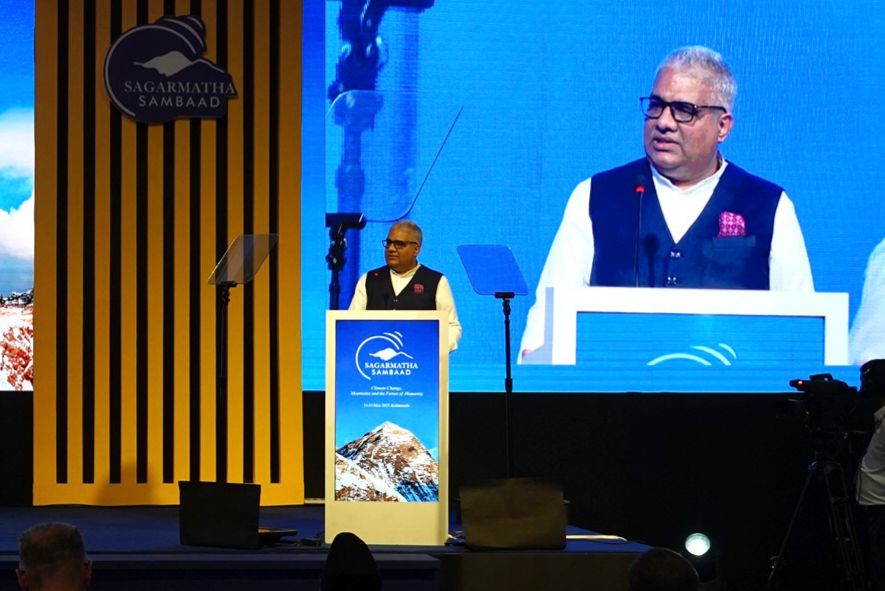Mountains Are Dying—India Demands Global Action at Sagarmatha Sambaad!

At the inaugural session of the first Sagarmatha Sambaad held in Kathmandu, Nepal, India’s Union Minister for Environment, Forest and Climate Change, Shri Bhupender Yadav, issued a powerful five-point call for global actionto safeguard fragile mountain ecosystems, emphasizing the critical role of the Himalayas in climate stability and biodiversity.
Held under the theme “Climate Change, Mountains, and the Future of Humanity”, the high-level dialogue gathered ministers, climate leaders, and international delegates from across the globe, including Nepal’s Prime Minister KP Sharma Oli, Foreign Minister Dr. Arzu Rana Deuba, China’s Vice Chairman of the National People’s Congress Mr. Xiao Jie, and COP29 President Mukhtar Babayev of Azerbaijan.
Representing India at this significant forum, Shri Yadav applauded Nepal’s leadership in hosting the summit and highlighted the shared ecological and cultural bonds between Himalayan nations. “The name Sagarmatha, meaning ‘Head of the Sky,’ captures both the grandeur of our mountains and the responsibility we carry to protect them,” Yadav stated.
A Global Call to Action
Shri Yadav unveiled a five-point agenda to guide global collaboration on mountain conservation:
- Enhanced Scientific Cooperation – Strengthening research and monitoring of cryospheric changes, water cycles, and biodiversity in high-altitude zones.
- Building Climate Resilience – Investing in adaptive infrastructure, early warning systems for disasters like glacial lake outburst floods (GLOFs), and climate-smart development.
- Empowering Mountain Communities – Prioritizing the needs, knowledge, and livelihoods of local populations in policy-making, with a focus on green jobs and sustainable tourism.
- Providing Green Finance – Urging predictable climate financing in line with the Paris Agreement to support mitigation and adaptation strategies in mountain nations.
- Recognizing Mountain Perspectives – Calling for the inclusion of mountain ecosystems in global climate negotiations and development frameworks.
He also stressed the disproportionate impact of the climate crisis on developing nations, noting that South Asia accounts for just 4% of historical CO₂ emissions while housing nearly 25% of the world’s population.
Cross-Border Conservation and Big Cats
A key highlight of Shri Yadav’s speech was his proposal for enhanced transboundary conservation, urging all Himalayan nations to collaborate under the International Big Cats Alliance to protect species such as snow leopards, tigers, and leopards.
Referencing India’s Project Snow Leopard, he shared that the country's first-ever national survey (2019–2023) had recorded 718 snow leopards, representing about 10–15% of the global population. The initiative aligns with Prime Minister Narendra Modi’s earlier call at the Convention on Migratory Species to safeguard the snow leopard’s habitat.
“Vasudhaiva Kutumbakam”: One Planet, Shared Responsibility
Concluding his remarks, Shri Yadav reaffirmed India’s commitment to collective ecological stewardship. “In the spirit of Vasudhaiva Kutumbakam—the world is one family—we must ensure that our sacred mountains continue to stand tall as symbols of hope and sustainability.”
The Sagarmatha Sambaad, named after Mount Everest’s Nepali name, seeks to become a recurring platform for global dialogue on pressing environmental and climate issues affecting mountain regions. With strong calls for solidarity and action, the 2025 edition sets a firm foundation for long-term ecological cooperation across borders.
India In Nepal



![From Kathmandu to the World: How Excel Students Are Winning Big [Admission Open]](https://www.nepalaaja.com/img/70194/medium/excel-college-info-eng-nep-2342.jpg)
